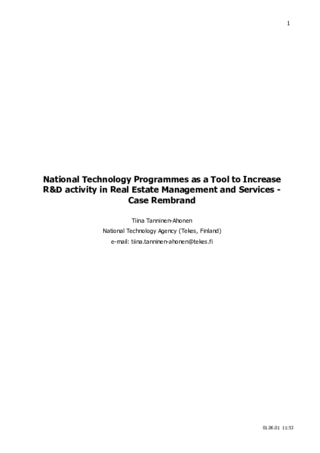The real-estate industry is running the risk of lagging behind in the global competition. The productivity increase in the sector has not been able to match the development of most other industries. The explanation put forward for this underperformance has been the lack of adequate allocation of resources to R&D that has led to suboptimal levels of innovation. Explanatory factors for the low levels of R&D spending has been sought in the fragmentation of the industry and a long tradition of regulatory intervention. The absence of a business climate has weakened the incentives for change and renewal, especially in the ownership sub-sector of the industry. One general way of promoting change and integration of the industry is to develop the ownership function to become a skilful and a perceptive intermediate between the various service providers (including the construction sector) and the end-user. Ownership has thus to be transformed from a passive possessor of assets into an active, customer oriented business unit that unites the various sub-processes into a service-business concept that adds value to the end userís core business. As the technical expertise and the research tradition in Finland are apparently not problems as such, the gap is to be found in the lack of competence to identify and, above all, to respond adequately to the real needs of the customer. Since global customers will not adjust their demands to outside influences in the form of e.g. traditions in a particular country, the Finnish Real Estate Cluster, will have to meet the ever increasing challenge of making its products more customer oriented. In addition to making products more tailored, this specifically implies that the service component of real estate products has to be acknowledged and focussed on. As more and more of the Finnish wealth originates from high-tech sectors where much of the investments are immaterial, we begin to realise that the notion of technology has broadened to a concept in which the fundament of a technology does not necessarily originate from a physical product. Even in the most generic definitions of technology it is realized that a technology is not just an ëartefactí or collection of artefacts i.e. physical items like machinery, but also includes the knowledge and skill which are required to make use of the artefacts. The basic technology equation (artefact+skill+knowledge) emphasises that technology is not just the physical product but the bundle of all three components. In the future, new technologies will equally likely be created from a service concept that consists of a unique combination of both services and physical products. Thus the concept of technology develops in line with the general evolution, where products are becoming increasingly customer oriented and tailored. In an effort to speed up this process a five-year R&D programme called Rembrand was initiated by the National technology Agency in Finland. The purpose of the Rembrand (Real Estate Management BRAND) technology program, with a volume of 20 Meuro, is to promote a functional integration of the fragmented real estate and construction industry in Finland. Competitive advantages will arise from the efficiency gains and the creation of new business opportunities that are the outcome the integration of the various sub-fields of this business sector. The integration will take place through the transformation of the activities into a service and customer oriented business environment. In the program, customer-oriented real estate business operations will be developed into service concepts to give the property user added value. The programme will last from 1999 to 2003. Its total funding is FIM 120 million (Euro 20 million), half funded by industry and half by Tekes. Currently there are 70 projects with a volume of 12 Meuros in the program. The projects sponsored range from firm-specific strategic developments of new service concepts to collective research projects focussing on some central topic e.g. the role franchising in the FM sector. In this paper, the structure of Rembrand Program, focussing on increasing the R&D efforts necessary for this fundamental change, is described. The main challenges for the success of such a large project are analysed and the intermediate results of the R&D projects sponsored by programme are discussed.
Tanninen-Ahonen, Tiina. "National Technology Programmes as a Tool to Increase R&D activity in Real Estate Management and Services Case Rembrand." In 8th European Real Estate Society Conference. ERES: Conference. Alicante, Spain, 2001.
Section: Real Estate and New Technologies
